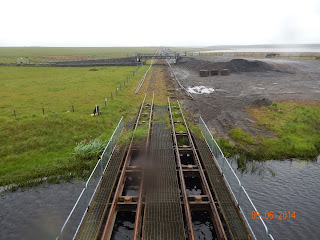 |
| Sightseeing in Wick - the mash tub at the Old Poultney distillery. John the distillery man, our guide Katie, and Susan |
Alan and Rosemary Towers had arrived the previous evening to
join me from the final two days of the walk. In view of the weather (awful) and
the route ahead (dull, all unavoidable road walking) they must have had some doubts,
but were too polite to voice them. Their loyalty is much appreciated.
So it was off in full battle gear on the road north. First
stop – Tesco – for an unappealing selection of sandwiches and alternatives
(sushi, in my case, which turned out to be awful as well). And then on with the
route march.
 |
| The ruined abbey at Wick |
There’s really not much positive to say about this part of
the world – particularly in weather like this. It’s flat, dull. The houses are
undistinguished; some seem as if they’re falling down, others look new but
uninhabited. The dominant finish is grey pebbledash. You could be excused to
think that no architect had ever made it north of Inverness.
The middle third of the walk was parallel with the dunes
behind the wide sandy beaches of Reiss and Keiss. They’re largely hidden by the
dune systems behind them. They would be delightful to walk on at low tide in
fine weather, but even then there’s the problem of the River of Wester that
neatly divides them from one another and would be impossible to ford. In conditions
as they were there was no temptation to check them out.
 |
| The pipeline manufacturing line at Subsea 7 |
At the mid-point of the beach there’s a major industrial
plant called Subsea 7. There’s a dead straight rail line from it stretching
over four and a half miles inland, and I’d had no idea of its purpose. When we
crossed it the rails seemed to have been lifted, but they were obviously still
working on the track’s bed, with diggers and other heavy equipment laced ready
for work. Fortunately an explanation was offered by a tiny plaque on the bridge
that crosses the track. It’s a manufacturing plant for underwater pipeline
clusters. Presumably great lengths are assembled on the track, and then pulled
out to sea for the North Sea oil fields. I imagine that there’s not so much of
this work nowadays, but the facility still seems active.
Keiss itself offered nothing. The Sinclair Bay Hotel looked
very unwelcoming, and the shop didn’t offer the coffee we’d have welcomed. So
it was onwards, with a brief stop at the village war memorial for a quick
lunch.
 |
| Keiss Castle - in need of a lick of paint |
Then it was past Keiss castle – or more accurately, castles.
There’s an ancient ruin on the coast, and a newer (18th or 19th
Century?) building set back from the shoreline. This shares the Scottish
baronial style of Dunrobin and Dunbeath castles, but is in severe need of
several coats of new paint. It looks rather sad.
The final stretch was back to the car park at Harbour Brock,
just before Auckengill, where Alan had parked the car that morning before our
walk. Just as we arrived the heavens opened, and we clambered waterlogged into
Alan’s lovely new BMW. And then it was on by car to John O’Groats. It seems
rather strange to arrive at one’s intended destination a day early, but there’s
really no other accommodation on the way there.
T
hat afternoon it was coffee at the rather good new café,
and then a trip to visit the new local boutique gin distillery in Dunnet (very
interesting) and then to see the lighthouse and cliffs at Dunnet Head – the
most northerly point of the British mainland. Here there are huge numbers of
nesting seabirds on the ledges below – including several puffins where there
was any room for a burrow.
 |
| Lighthouse at Dunnet Head |
So there’s only one day to go.
Wet, cold, miserable; not
a trace of sunshine until well after we’d finished the day’s walking. 10 to 11C.
16.55 km; 130m of ascents and 93m of descents. A99 all the way.
No comments:
Post a Comment